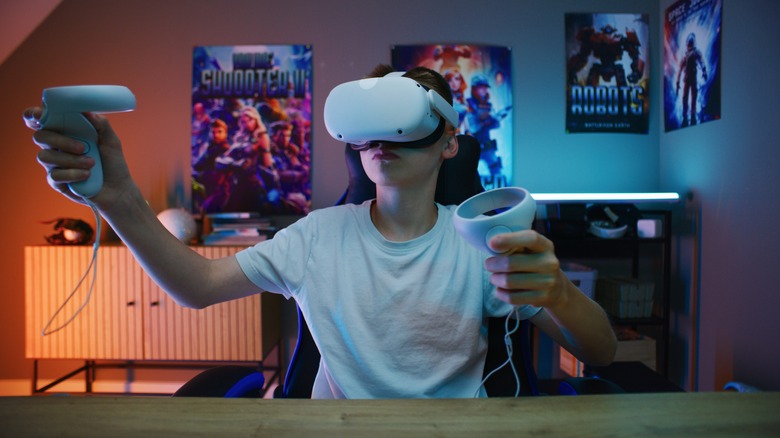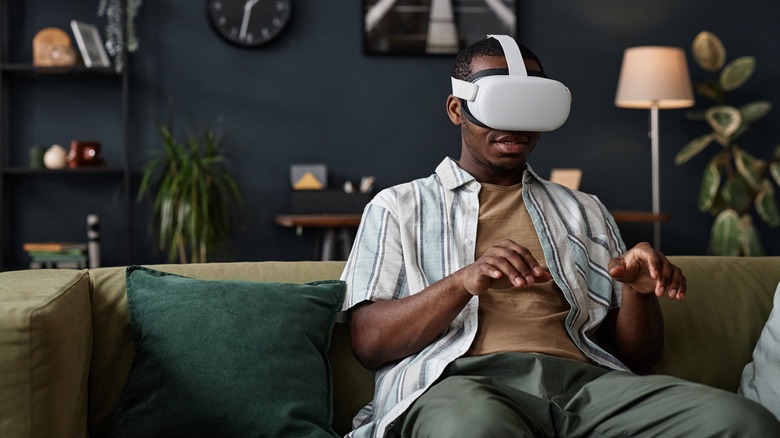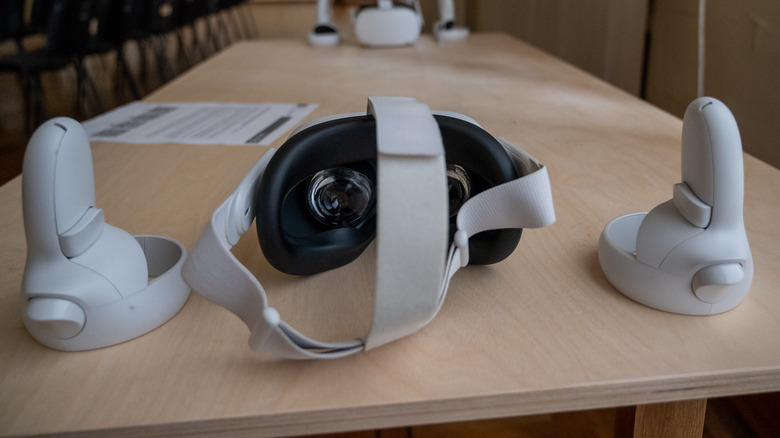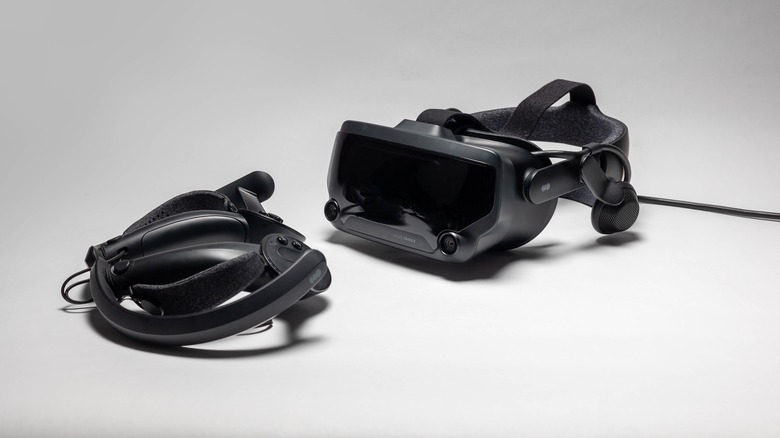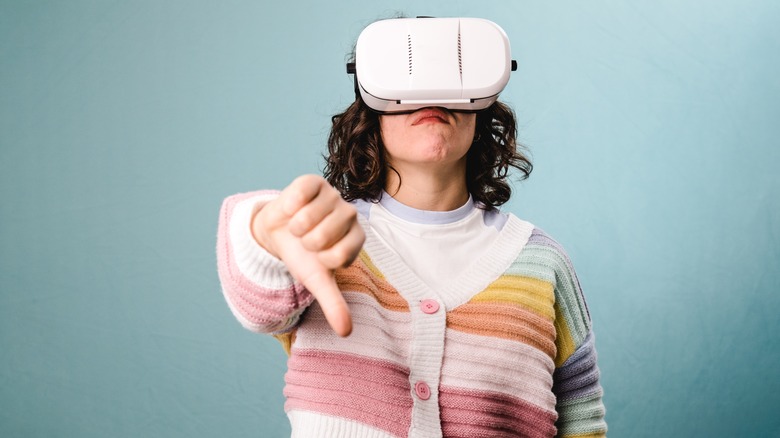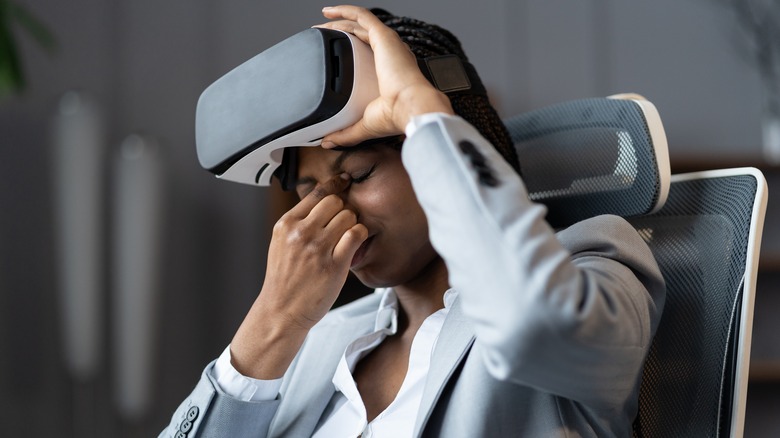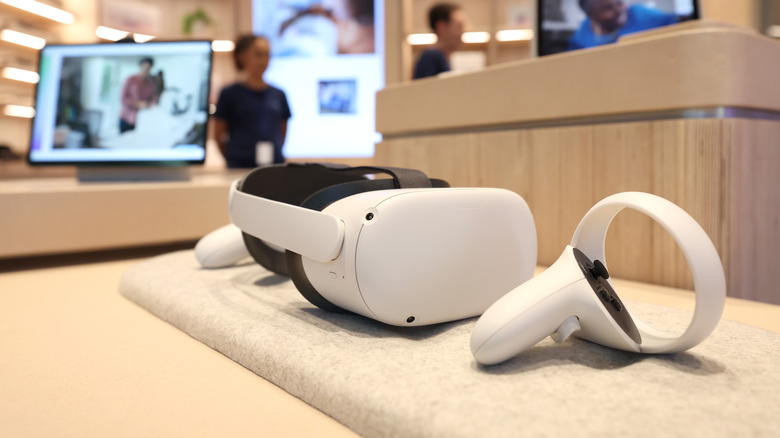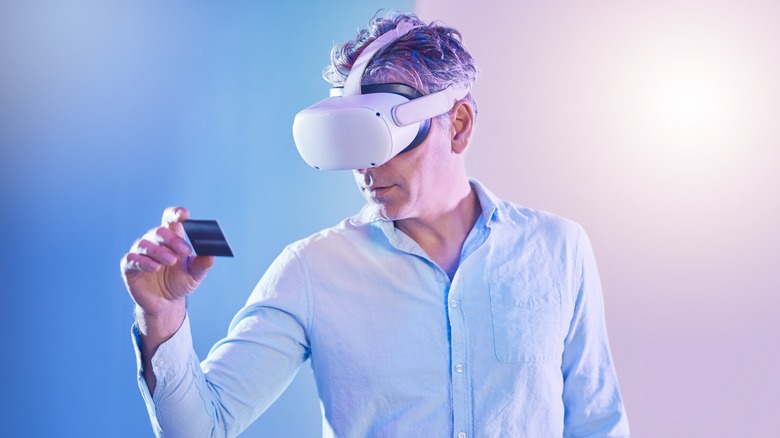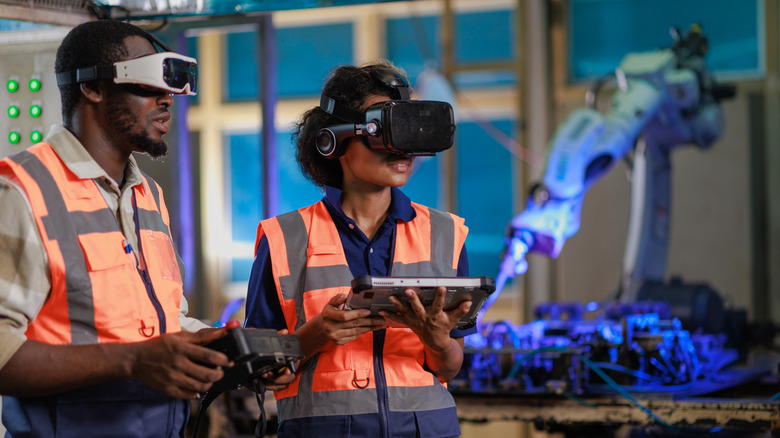Can A Mixed Reality Headset Really Replace Your Desktop PC? It's More Complex Than You'd Think
When science fiction isn't a word of caution — or thought-provoking speculation — it's often imaginative wish fulfillment of tech we wish we had. VR goggles especially. Stanley Weinbaum's "Pygmalion's Spectacles" envisioned the idea way back in 1935, and Neal Stephenson's 1992 cyberpunk classic "Snow Crash" painted a hyper-immersive metaverse before most folks knew what email was. People have been dreaming of a "Ready Player One" future for years, but arguably, we're already there — photorealistic graphics aside. VR is affordable (anyone can transform an old phone into a VR headset), and modern headsets are capable of creating deeply immersive interactive environments without being a constant gaming PC accessory. So why aren't we all flicking video files around like Tom Cruise in the intro scene of "Minority Report" instead of doing so tediously with a mouse cursor?
Ask Silicon Valley, and their tech demos would have you believe that mixed reality is good enough not to just add to your desktop device, but to be your desktop device. Mark Zuckerberg's Metaverse and the Apple Vision Pro propose intuitive ways to improve our lives, focusing on practical, everyday applications of spatial computing that extend your digital workspace out into your real environment.
Well, I own the excellent Meta Quest 3, and I've tried replacing my desktop PC with it for fun. I have some thoughts. It's time we talked about how close a VR headset is to replacing your daily driver — and the many ways it falls short.
The promise of working everywhere is really here
Just a decade or so ago, your VR headset needed a room full of sensors, controllers, and a direct wired connection to a PC or console to run. Not anymore. The big selling point of modern mixed reality headsets is that you can take your virtual world anywhere and dive into it on a whim. To give Silicon Valley advertising some credit, this part is real. My Meta Quest automatically determines the boundaries and obstacles of any room I'm in and remembers them for future visits. Passthrough mode allows me to always be aware of my environment without taking my headset off, so I avoid knocking things over and stay conscious of other people. Controllers are optional thanks to complete hand tracking control. The headset also supplies its own processing and battery — no wires means no tripping hazards. Long story short, the Quest 3 (and others) brings everything along for the ride.
In all seriousness, I really can pull it on almost anywhere, at almost any time, and pick up where I left off. Doesn't matter if it's on my couch or in a library, doesn't matter if I left my laptop at home — I can spin up a multi-monitor workspace similar to my home office and check social media, send emails, watch videos, and so on. And thanks to the travel mode now included with the Quest by default, I can do so from the stricter confines of my economy-class flight. That's to say nothing of the caveats and limitations, sure, but bringing a virtual workspace with you wherever you go is feasible, at least.
Screen real estate ceases to be a concern
Portability of the virtual workspace aside, I'd say the biggest benefit to a mixed reality setup is that there are screens galore. The Quest can stream up to three from my computer, plus another two virtual ones. And these screens can be as big as I want them. I've transformed my modest living room into a spacious home theater just by hitting fullscreen on Netflix — all while in Passthrough mode so I can keep the homely ambiance. For those who are tired of squinting at a teeny tiny 13-inch laptop but hate giving up the portability that comes with it, VR could be just what the doctor ordered.
The Quest's 2064 x 2208 per-eye resolution is grainy-looking, but the effect does at least trick my brain into thinking those big screens maintain a decent picture quality. The 120 Hz max refresh rate also keeps everything smooth without spending big on costly gaming monitors. And since the Vision Pro is bringing an ultrawide virtual screen to visionOS 2 and Meta has nicked features from the device in the past, I might be able to enjoy that experience without selling my soul to the devil for a proper ultrawide monitor.
Virtual screens work in addition to physical screens, too, although the latter will look awful in Passthrough mode. The displays remain where you place them in the virtual space so you can easily arrange your digital workplace around your physical one — positions that are persistent across sessions. For some, a headset is a much cheaper alternative to a big, multi-screen setup.
Peripherals get to stay along for the ride
Virtual keyboards will kill your joy of typing. Even with practice, the lack of physical sensation forces you to hunt and peck — introducing countless errors along the way. That's probably never going to change. As luck would have it, Bluetooth peripherals like keyboards and mice work great with a headset in Passthrough mode. My Quest creates a 3D representation of my MX Keys S keyboard so the hand tracking doesn't freak out when I'm typing. My mouse works too, although there's no official support for the model from Meta. Depending on how close my thumb and index finger rest on it, I could accidentally trigger some pinch gestures. Still, it gets tiring pretty quickly to keep my arms raised to interact with the virtual screens, so normal peripherals are a godsend.
The only major downside here is that Passthrough mode needs really good lighting for the keys to be legible, and there may be movement and wide-angle distortion until update v66 rolls out to all users. Also, Quest's point of view differs slightly from my actual physical perception, so I've had to re-train my brain to ensure my fingers and hands land where I want them to. Despite all of this, I could theoretically bring only a keyboard and mouse with me (plus my headset) while working away from home. That's a full, multi-screen setup that fits into the average backpack.
Controllers need not apply
The Apple Vision Pro wowed audiences with its complete lack of controllers, but hand tracking was already available on the Meta Quest 3 prior to its release — in addition to a handful of other features. The Quest shows a 3D overlay model of my hands and allows me to point and pinch to manipulate the virtual world to my heart's content. The controllers are more accurate and give me more functionality, but they're also an extra thing to carry around. And if I attach them with their hand straps, they quickly become a pain to put on and take off. Still, I'm very impressed with how much I can do in the virtual space without ever touching a controller, including playing a handful of supported games.
Hand tracking is still far from perfect. Even with the latest update, I frequently have to repeat a gesture or correct for a misfire. When I set my hands down on my lap or the table, I have to keep my index fingers and thumbs apart to avoid an accidental pinch gesture. Plus, some features are currently limited to controllers — every time I try to set up a new workspace boundary, my Quest tells me I cannot proceed with just my hands. Meta has a long way to go to catch up with the Apple Vision Pro's reportedly sublime gesture control, but the current hand tracking is a serviceable stopgap for now.
(Good) VR is going to cost you
VR adoption still has one constant barrier: It ain't cheap. It's definitely more affordable than it used to be, make no mistake. You can grab the Meta Quest 2 — a great headset — for just $200. Others can go as low as $65. Remember, the original Oculus Rift retailed at $600 in 2016, and that was supposed to be affordable at the time. Despite how the market has dropped VR prices, though, you probably want a top-of-the-line headset to replace your desktop, not a cardboard box with a phone in it. You'll need that snappier processing, higher-resolution display, and upgraded storage space if you don't want to test your patience with the cut corners of cheaper headsets. That privilege will cost you big, even in the current year.
I'm not even going to bother recommending the Apple Vision Pro, which is $3,500 for an arguably beta device. Still, good VR alternatives to the Pro aren't cheap. My Meta Quest 3 cost me $500 at retail, and that's only with 128 GB of space. The PlayStation VR2 costs $549.99, plus $59.99 for the PC adapter you need to use it away from your PS5. Others like the HTC VIVE Pro 2 and Valve Index easily clear the thousand dollar threshold, and they're tethered devices unlike the Quest.
If you want to play PC-based VR games in addition to working in mixed reality, you'll have to shell out even more for a compatible graphics card. Mid-range options will run you around $600 — the price of a decent gaming PC or mid-range smartphone. All things considered, VR's something you'll have to budget for well in advance.
Battery life is the main limiting factor
Right out of the gate, the thing that's going to kill your mixed reality workspace is the limitation of lithium-ion batteries. My Meta Quest only gets about two hours of battery, plus a bit more with power saver on — at a noticeable cost to graphic fidelity and performance. It takes at least an hour to charge it back up with the included plug. Working for two-hour stretches interrupted by one-hour charging breaks obviously isn't practical.
You could plug into a USB charger or charging brick while using your VR headset, but Meta itself advises against this for the health of your battery. Even if you aren't concerned with its longevity, I don't recommend doing so — a cable hanging down and rubbing against your shoulder every time you turn your head is going to drive you up the wall, and you risk damaging the USB-C port if it gets snagged on something. The only solution to this is to get a battery strap, but this adds more weight and costs $129.
Pain and eye fatigue will be your new best friends
It doesn't even matter that the battery on VR headsets is unsatisfactory because there's an even bigger problem: discomfort. Sadly, these devices haven't changed much in size and weight since the models from the 80s and 90s. A front-heavy device hanging off your face can really put strain on your neck, face, and head. Every time I take off my headset after spending even an hour immersed, my cheekbones and forehead are sore, and I've usually got at least a light headache from the pressure induced by the strap. My hair gets messed up, and I'm lucky if there's not at least a pinch of cybersickness (i.e. digital motion sickness) to go with it.
Then there's the eye fatigue. Staring at two screens that sit less than an inch from your eyeballs, to the surprise of absolutely no one, is exhausting. It's like the headache you get from holding your phone too close while doomscrolling, multiplied sevenfold. After two hours of VR, I'm in desperate need of a cold turkey screen break. I genuinely cannot imagine how someone could work in mixed reality for 8 hours a day, even if Meta's Ray-Ban glasses could pack Quest 3 power into that form factor. And as a former glasses wearer (hallowed be thy name, LASIK), even they created a miserable ache on the bridge of my nose and behind the helix of my ear.
Mixed reality doesn't bring much to the table — yet
Mixed reality work sounds cool, in theory, but when you sit down and think about it you realize pretty quickly it doesn't do anything you can't happily live without. Sure, it's nice to have those big screens and the potential to work in a virtual office with co-workers. But ... that's basically it. And frankly, VR more frequently degrades my experience in certain areas than it improves it. Pointing and pinching is a more error-prone, less-efficient means of interaction compared to tactile interfaces like smartphones and desktops. The same goes for controllers. Unless I'm using my Bluetooth peripherals, it takes me two or three times as long to do something unaided in VR. Mixed reality, for lack of a better analogy, is just a glorified virtual multi-screen setup.
Now, I'm not implying that VR is redundant or useless. Doctors are beginning to use it as an aid during surgeries. Artists could use it as a more immersive way to manipulate 3D models. Experts believe it could be a helpful tool in a wide variety of contexts from education, to therapy, to training simulations, to home and real estate design, and more. But as far as making the average desktop experience better, I'm not seeing much beyond an expensive gimmick. Maybe there is some groundbreaking new use case — some way that VR could revolutionize how I work behind the desk. We've yet to discover that thing.
Should you make your desktop into a mixed reality setup?
VR is a ton of fun, let me be clear. Time flies by whether I'm playing "Half Life: Alyx" or using my Quest 3 to put my work up on a needlessly large virtual screen. Meta keeps expanding and refining the platform at an admirable clip, and I have to give the company credit for keeping its contributions to VR open and relatively affordable. Apple is also making welcome strides in this market, price aside. I don't regret purchasing my headset. But would I recommend it as a mixed reality desktop? Not at all.
I could point to how the battery life is poor, or that it's uncomfortable to wear a headset for any extended period. Instead, just look at any workspace — whether a home office or a corporate cubicle sprawl. Everyone is happily at work with physical screens and peripherals despite VR now being more accessible and affordable than ever. I rest my case.
VR, for now, is a toy. A fun toy, but a toy nonetheless, perhaps evidenced by a 2024 YouGov poll that found only about 15% of Americans own a headset. Meanwhile, the U.S. Census Office Bureau says over 90% of households have a computer, and Pew Research says over 97% of individuals own a phone. Clearly, there's no broad incentive to make your desktop a fully VR setup. If there was, you'd see those numbers climb, and people would be using headsets more often in the wild. This is the way I see it: If I had to choose between my MacBook or the Quest 3 for just about any task (in or out of the home), the MacBook would win every day.
The way forward
The problem with VR/mixed reality is that the novelty sells easy. Put a headset on a first timer and their mind is blown so much they might buy one on impulse. But that novelty wears off fast. Like, really fast. By the end of the first week using my Quest 3, the charm was all but gone. The VR games run out, and then you try — and probably fail — to incorporate your headset into your desktop workflow. Eventually, it gathers dust. Nowadays, I only use mine a couple of times a week, and usually out of a sense of guilt — or as an excuse to be active and play video games at the same time. The situation reminds me a lot of those now-extinct 3D movies.
VR and mixed reality needs to find its Apple Intelligence moment. Prior to the announcement of the software at WWDC, AI features in smartphones were hit or miss. Some were true game-changers — think Pixel's Call Screen. Most others were fun to play with, but ultimately forgotten after the first couple of uses. The Samsung Galaxy S24 Ultra's forgettable artificial intelligence features come to mind. Then Apple found a way to make its AI software into something people will probably actually use everyday with a new Siri, Writing Tools, and Genmoji.
If mixed reality developers crack the Apple Intelligence code — make people feel like they're missing out big time on VR — headsets will fly off store shelves and a new era of virtual reality will begin. It's impossible to say exactly what that change would be other than a general paradigm shift of how we interact with our headsets. Until then, don't buy one for much else beyond gaming.


